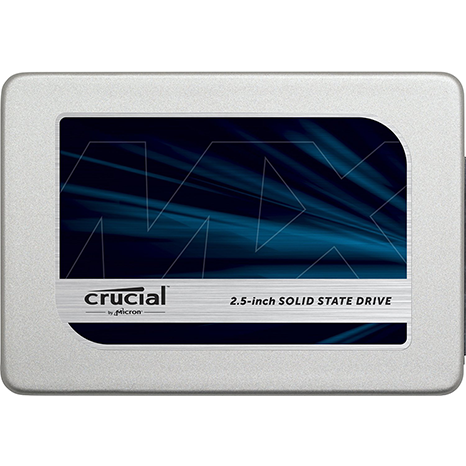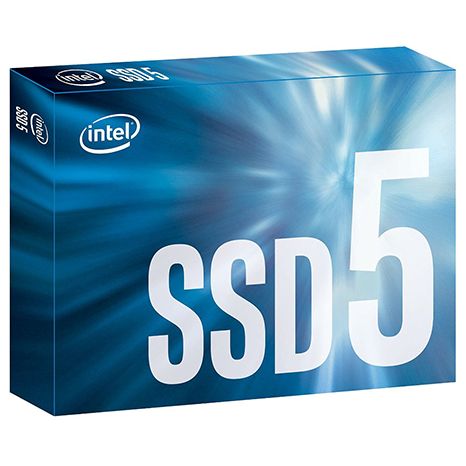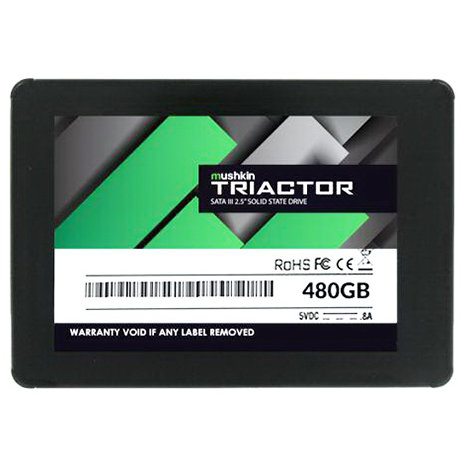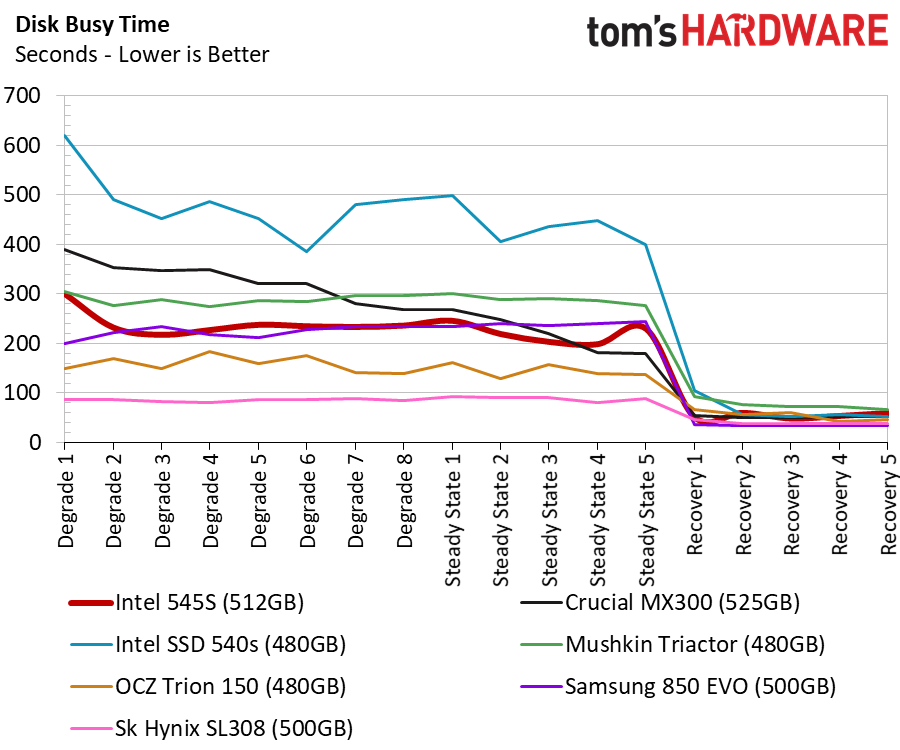Intel SSD 545s Review
Why you can trust Tom's Hardware
512GB Performance Testing
Comparison Products
MLC has given way to TLC for both SATA and the NVMe PCIe SSDs that dominate the enthusiast market. SATA is more or less boring at this point, but it still delivers exceptional value. If you have an older computer, an SATA SSD upgrade is the easiest path to increased performance.
New 3D flash technologies should increase bit output from the fabs and reduce retail prices in early 2018. Over the next few months, we'll see products with planar (2D) NAND slowly fade away as new 3D models emerge. We even expect Samsung to release an 800 series with new 64-layer V-NAND by the end of the year.
Most of the comparison products in our test pool should disappear by the end of the year. The Crucial MX300 with 32-layer 3D NAND is the exception. It should live into 2018 either as-is or with an update to 64-layer NAND. Intel is replacing the 540s with the 545s. The previous-generation 540s features 16nm Sk Hynix planar NAND.
The Mushkin Triactor, OCZ Trion 150, and SK Hynix SL308 are all still available but have moved off the radar due to high prices and sometimes limited availability. The Samsung 850 EVO 500GB is still the gold standard. Intel hopes to dethrone the 850 EVO with the 545s.
Sequential Read Performance
To read about our storage tests in-depth, please check out How We Test HDDs And SSDs. We cover four-corner testing on page six of our How We Test guide.
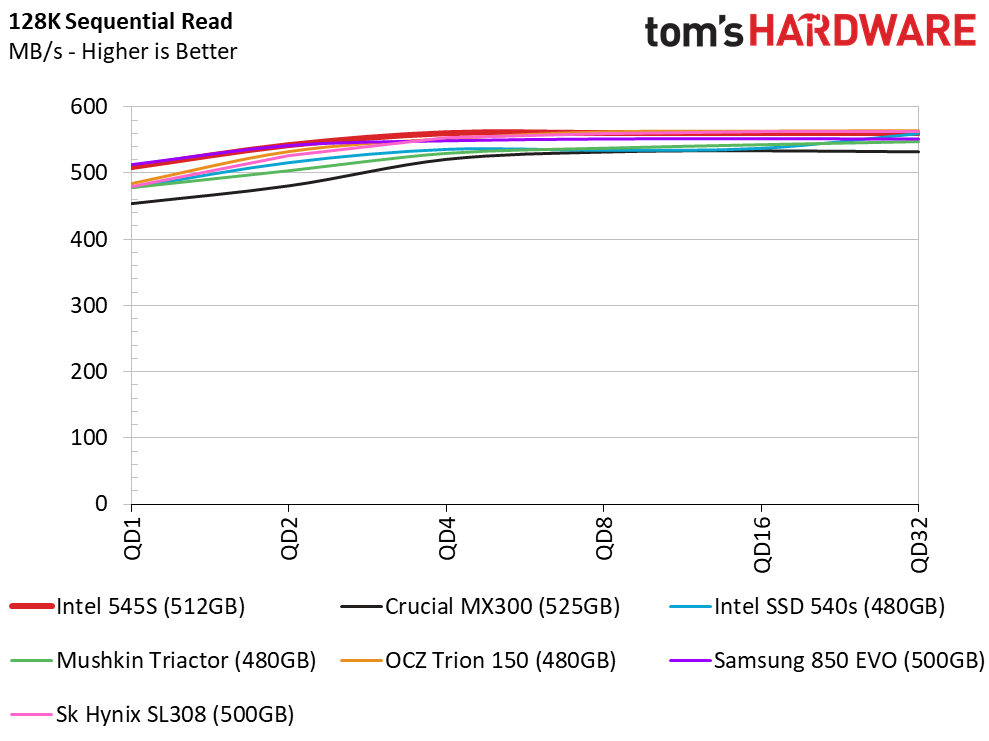
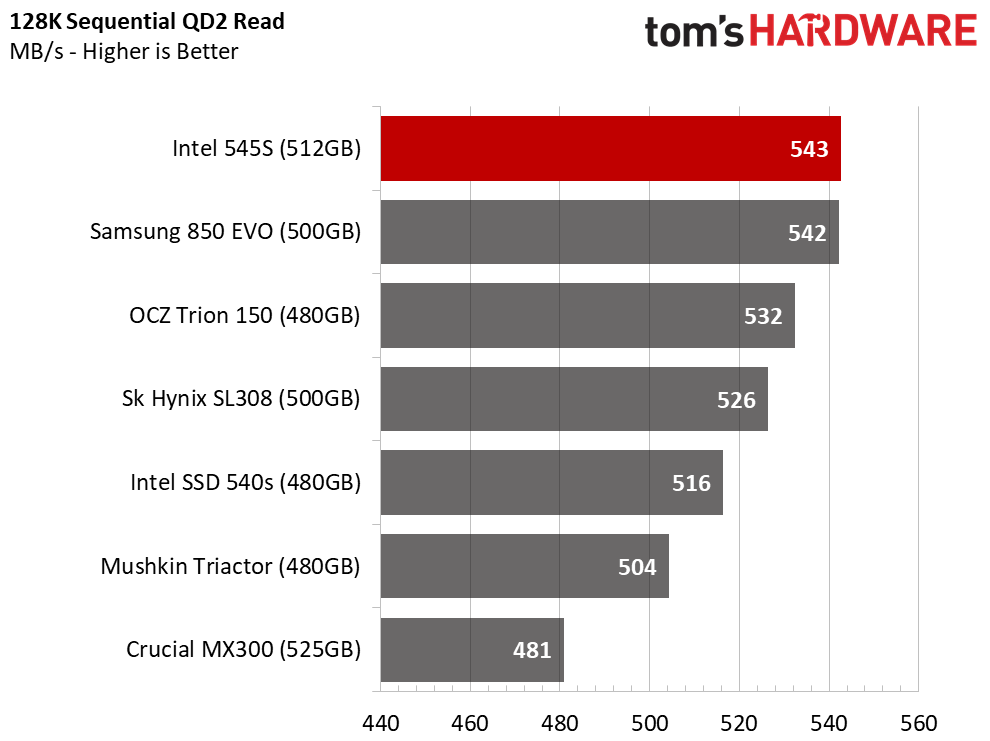
The Intel 545S starts out strong with excellent sequential read throughput that matches the Samsung 850 EVO 500GB. The 545s provides over 540 MB/s at queue depth (QD) 2.
Sequential Write Performance
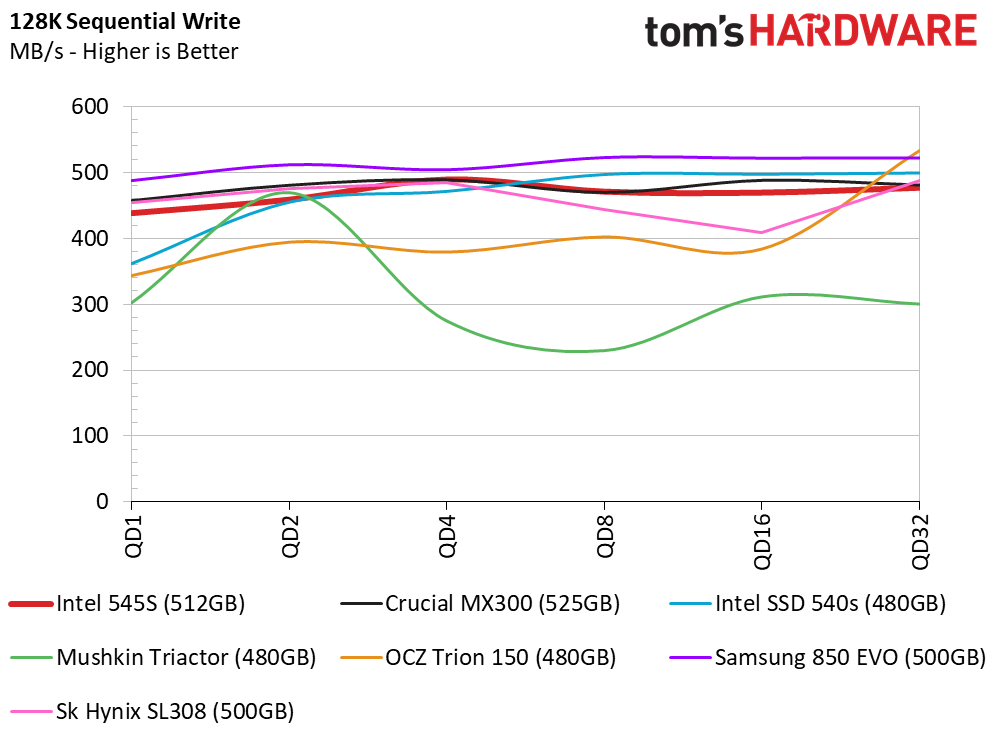
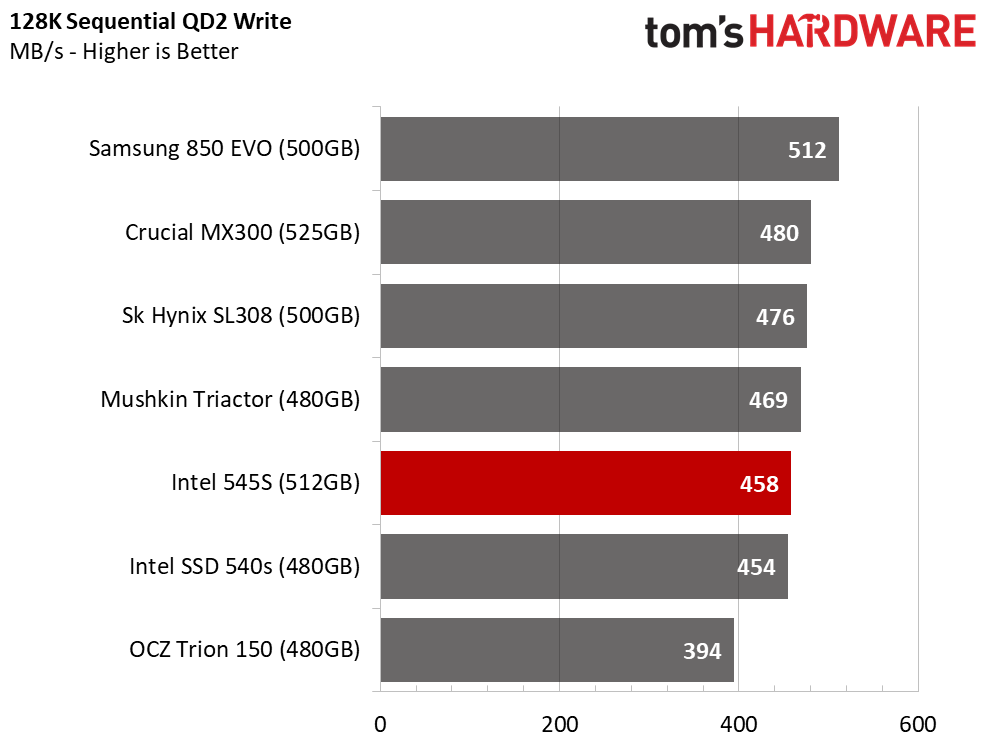
The 545s's second-generation Intel 3D NAND provides a nice QD1 performance increase compared to the first-generation 3D NAND in the 540s. Both mainstream drives provide nearly identical sequential write performance as they scale beyond QD1. Both drives fall to the bottom of the QD2 chart and trail the Samsung 850 EVO 500GB by roughly 50 MB/s.
Get Tom's Hardware's best news and in-depth reviews, straight to your inbox.
Random Read Performance

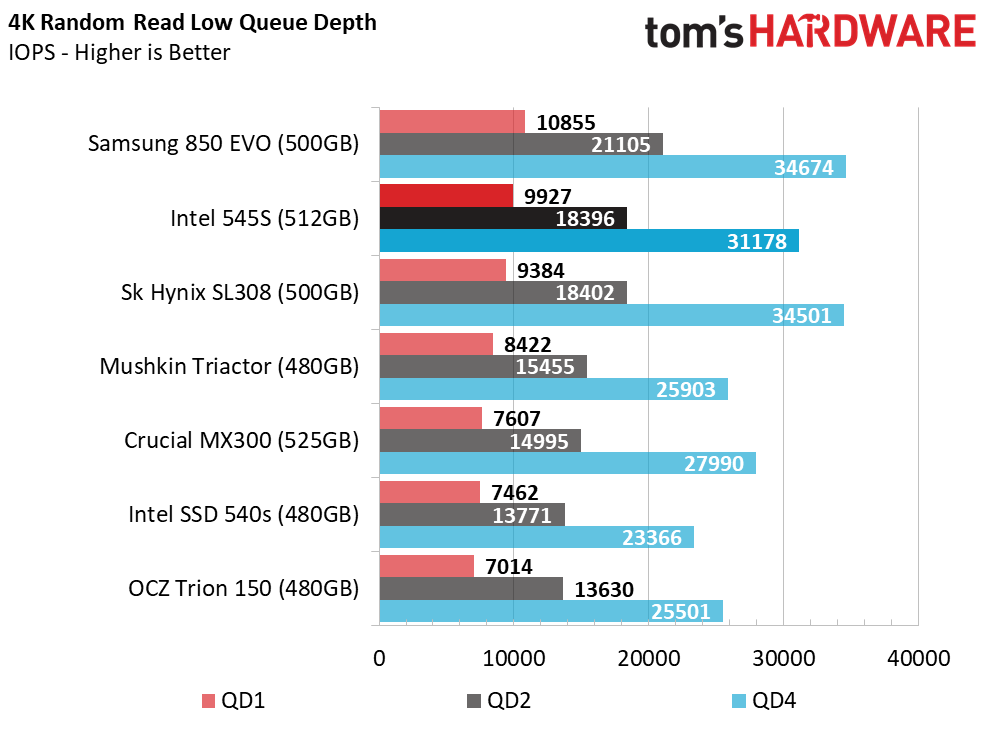
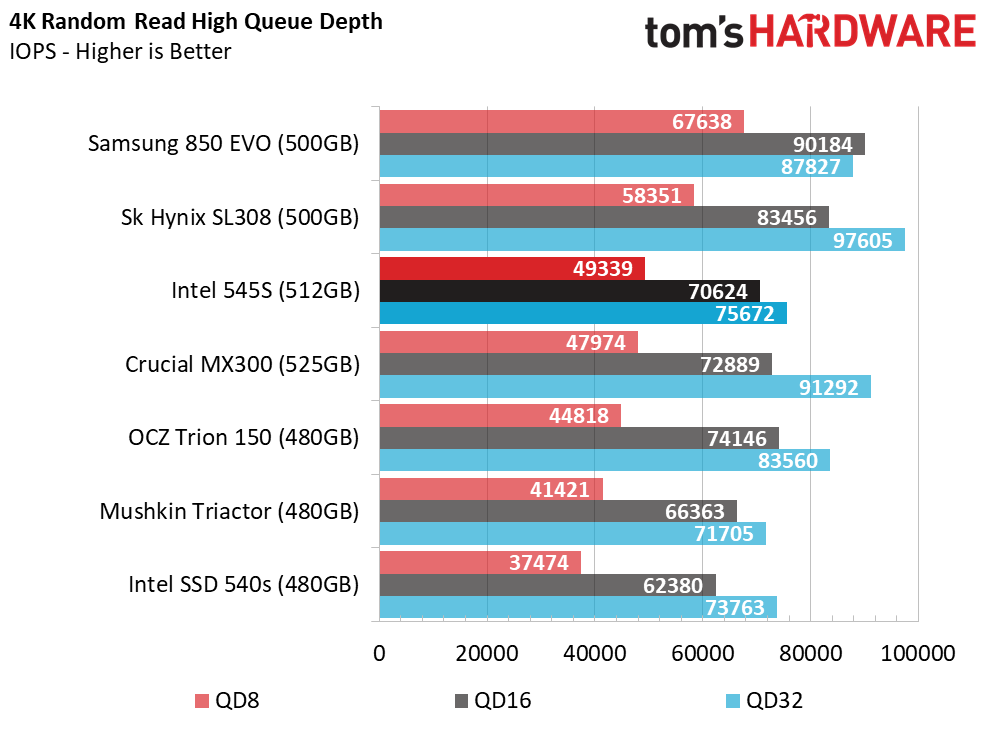
Intel increased the all-important random read performance with the new controller and NAND combination. The 545s is just under 10,000 IOPS at QD1. It also scales very well as the workload intensifies.
Random Write Performance
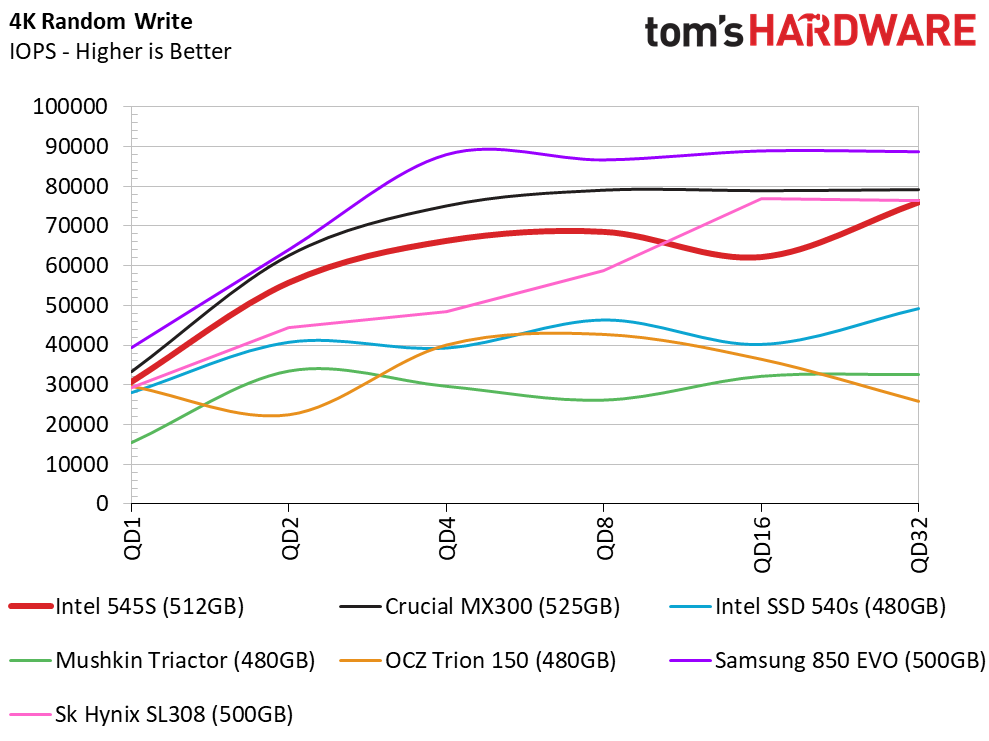
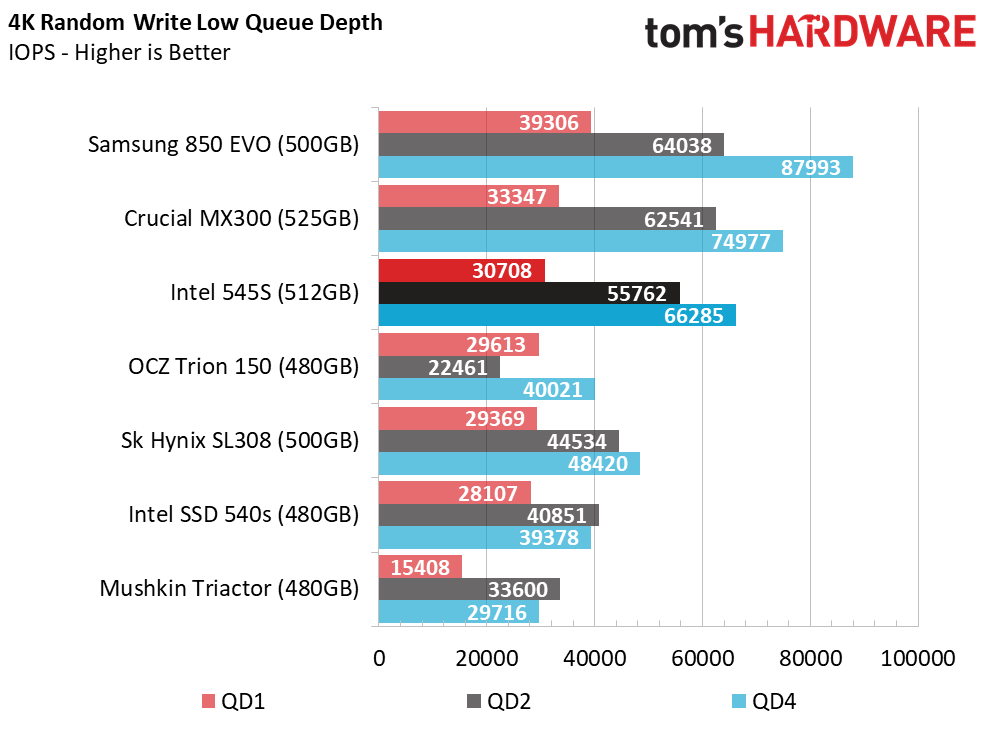

The Intel 545s also provides improved random write performance compared to the previous generation. Random write performance at QD1 is nearly identical, but the new flash allows the drive to scale much better as we ramp up the queue depth. The new model is also much more consistent in all of the 4-corner workloads.
80% Mixed Sequential Workload
We describe our mixed workload testing in detail here and describe our steady state tests here.
The increased consistency gives the Intel 545s a leg up in the mixed workload tests. The 545s has excellent scaling as it runs up the queue depth range during the 80% sequential read workload.
80% Mixed Random Workload
The Intel 545s starts out strong at QD2 in the mixed random test. It actually edges out all of the other drives on the chart at QD2. The Samsung 850 EVO 500GB steps out of line at QD4 and then walks away further up the queue depth range. The 545s provides a massive improvement over the older 540s.
Sequential Steady-State
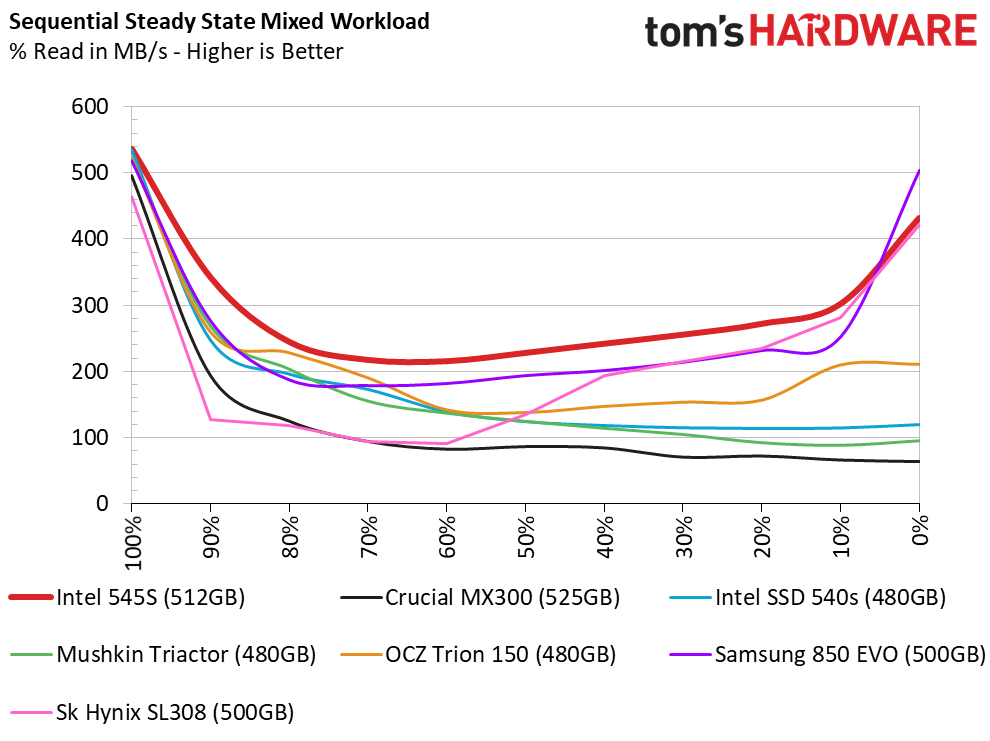
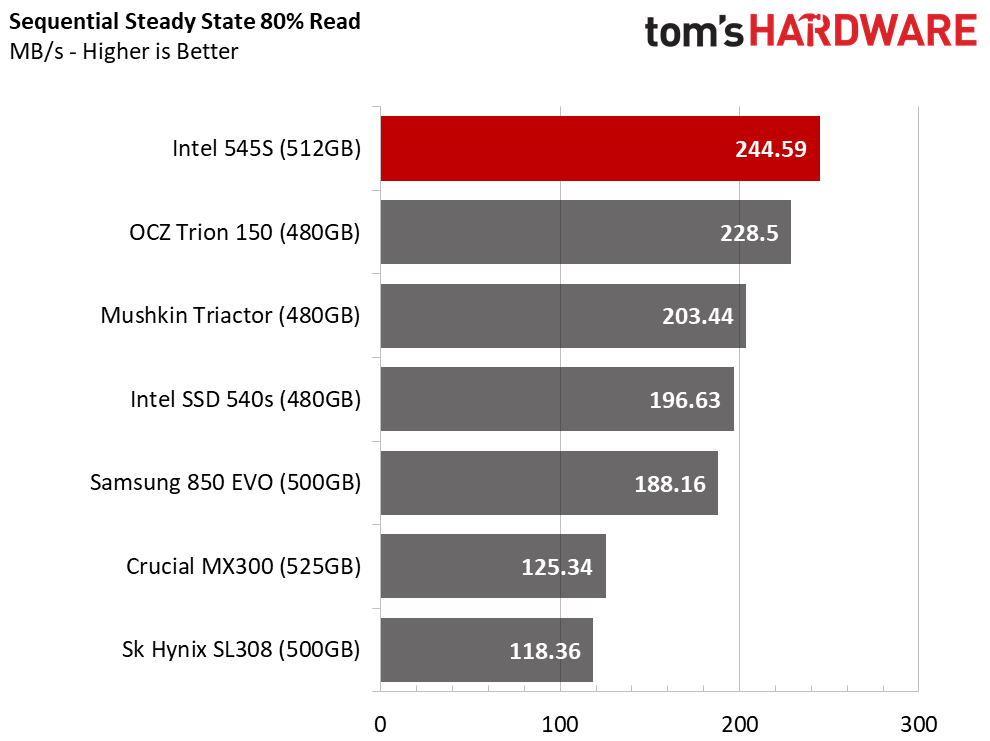
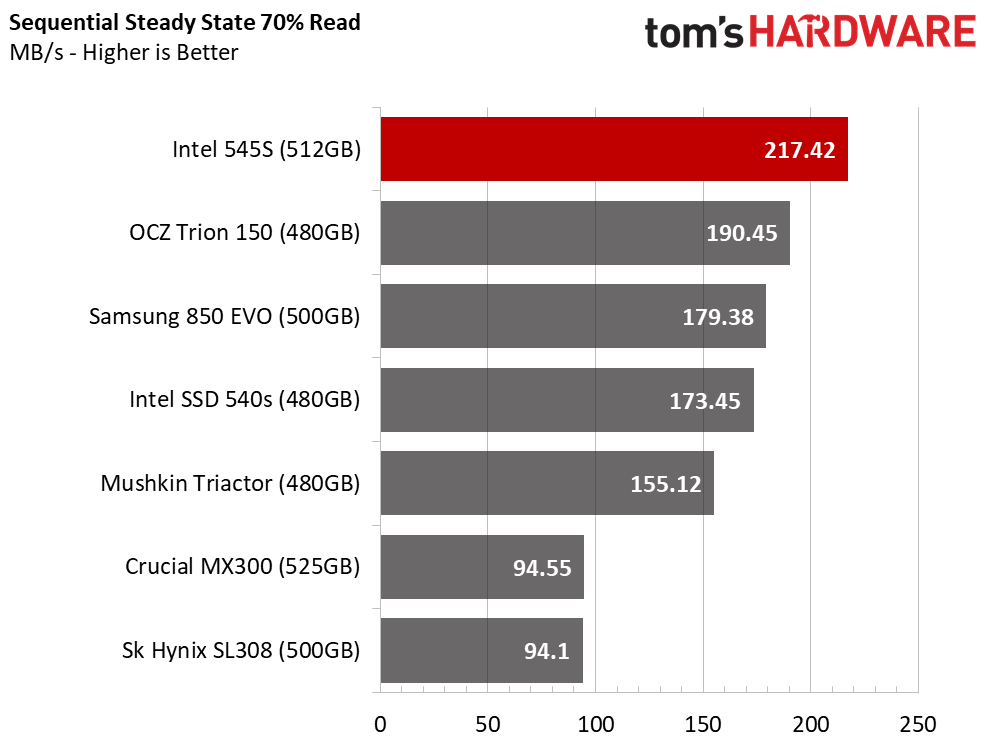
The 64-layer NAND paired with the new custom controller provides impressive performance for a TLC SSD in steady state. We observed the regular downward slope on the left side of the chart as we mixed in more write traffic, but the 545s bucked the trend of reduced performance, which shows as a flat line, as we reach the left side of the chart. The IMFT TLC acts quite a bit like MLC and follows a traditional bathtub curve.
Random Steady-State
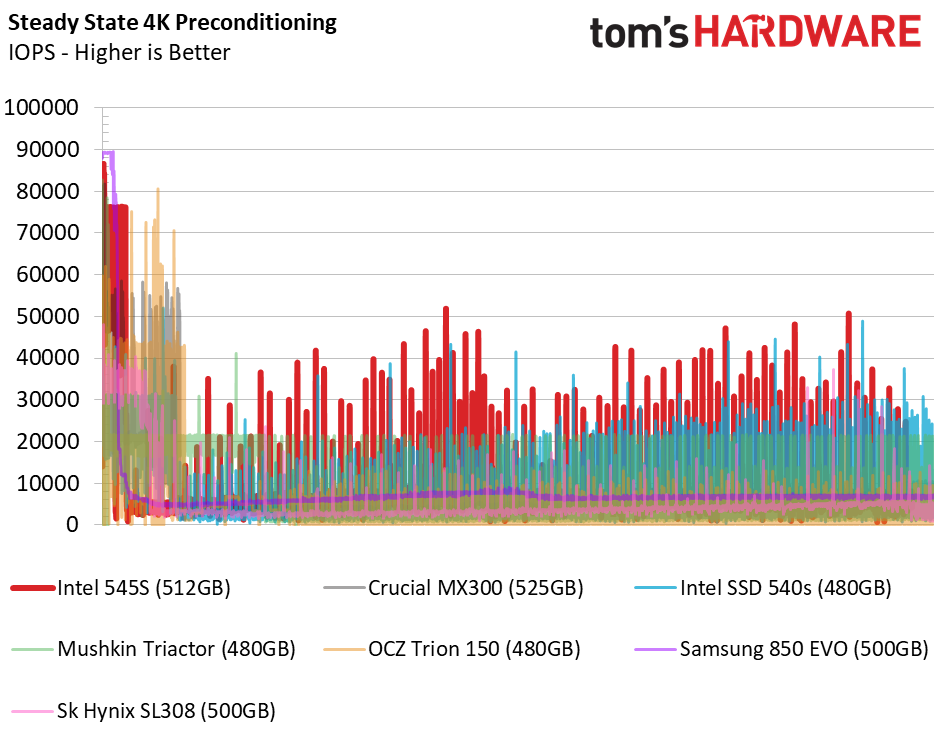
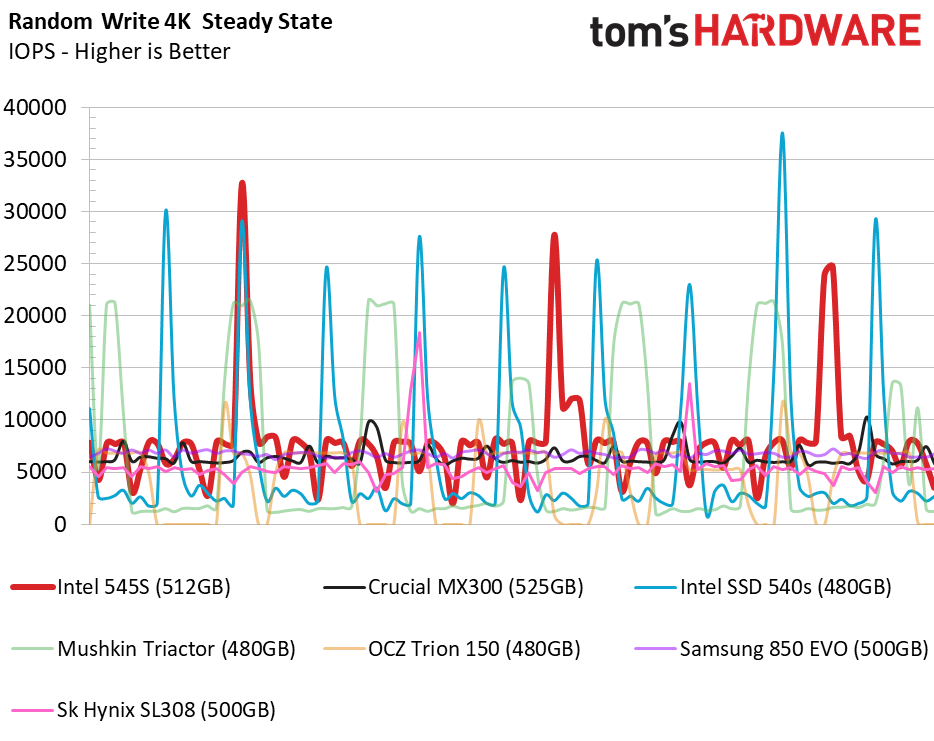
Intel still hasn't mastered making TLC as consistent as many of its previous generation products. That's always been the hallmark of Intel consumer SSDs. We wouldn't recommend the 545s for use in RAID, but nearly all consumer SSDs are moving over to TLC. This might be the best SATA has to offer for a while.
PCMark 8 Real-World Software Performance
For details on our real-world software performance testing, please click here.

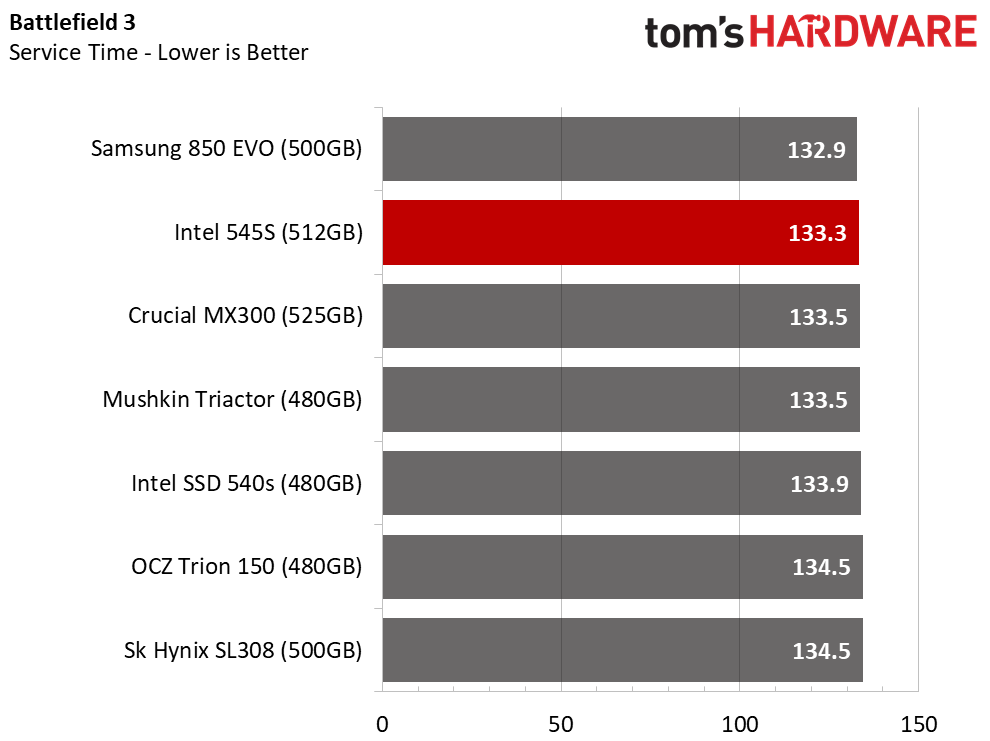
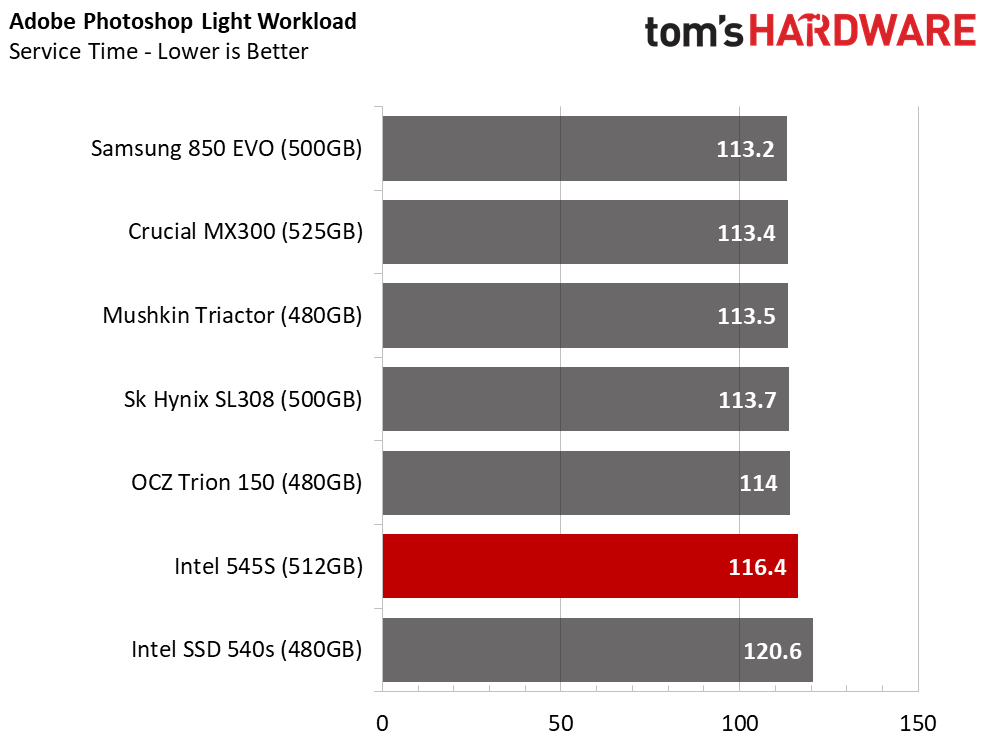
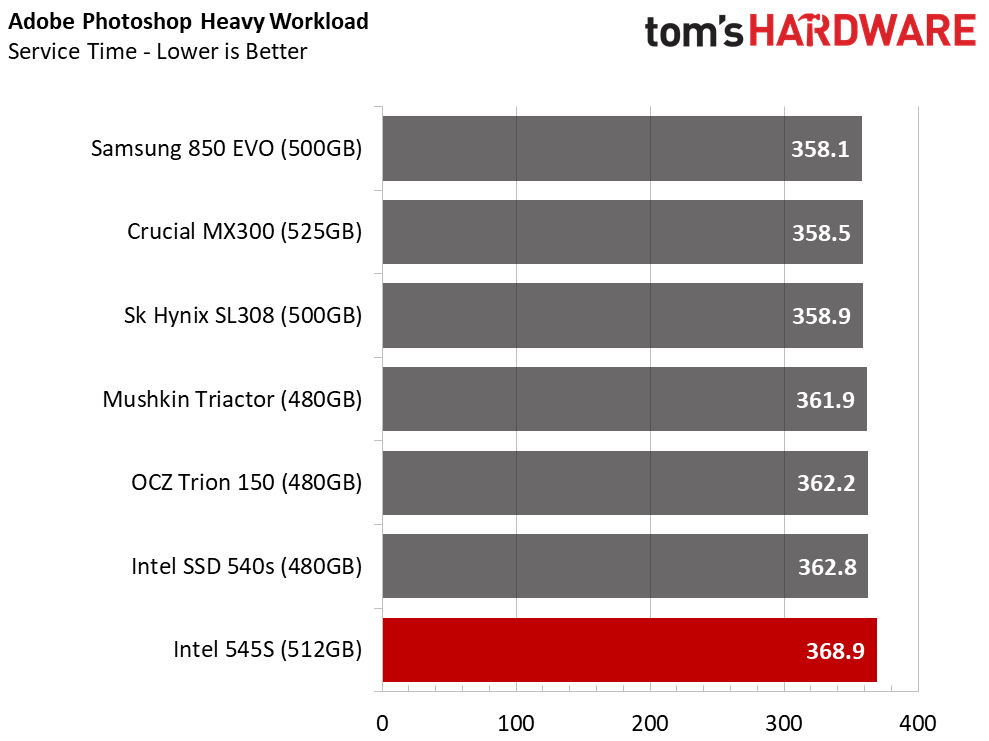

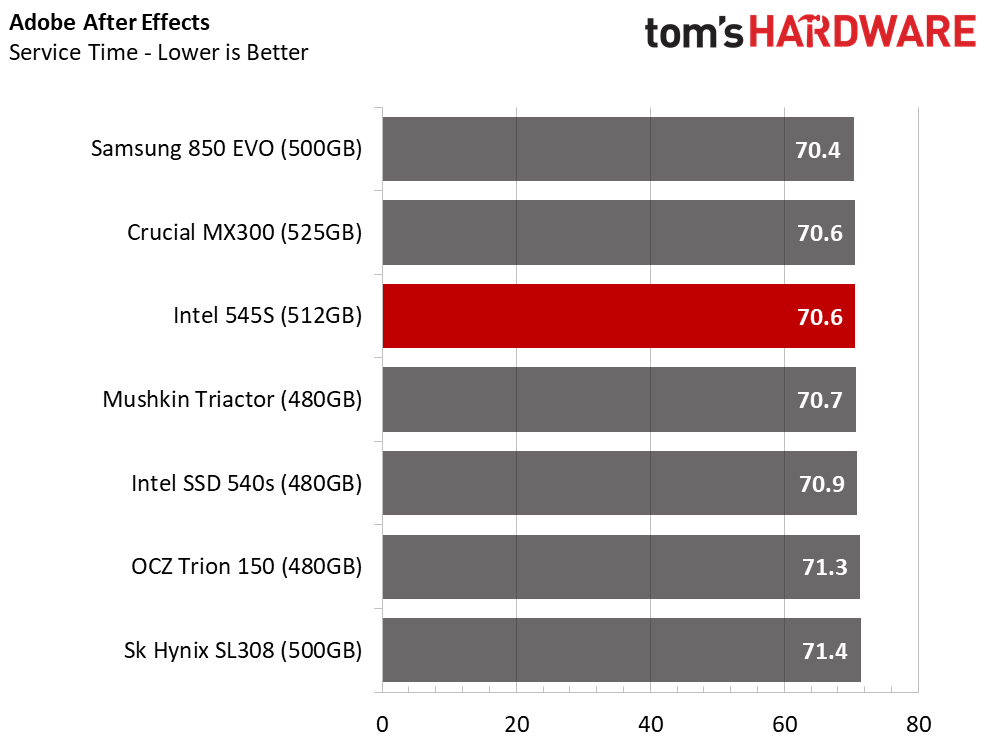

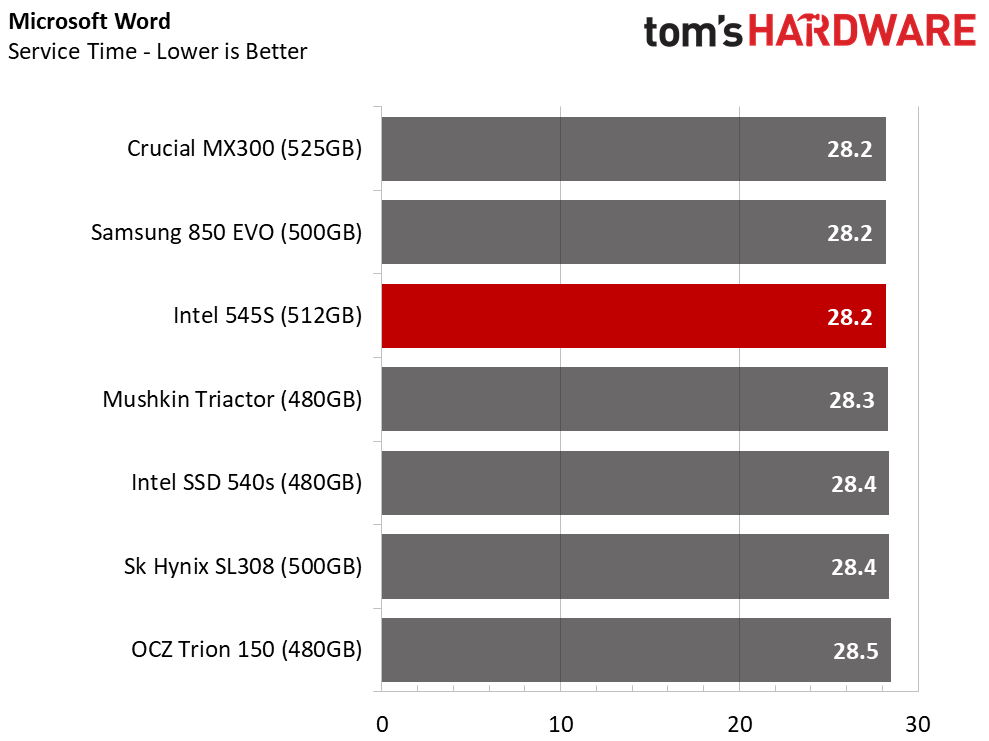
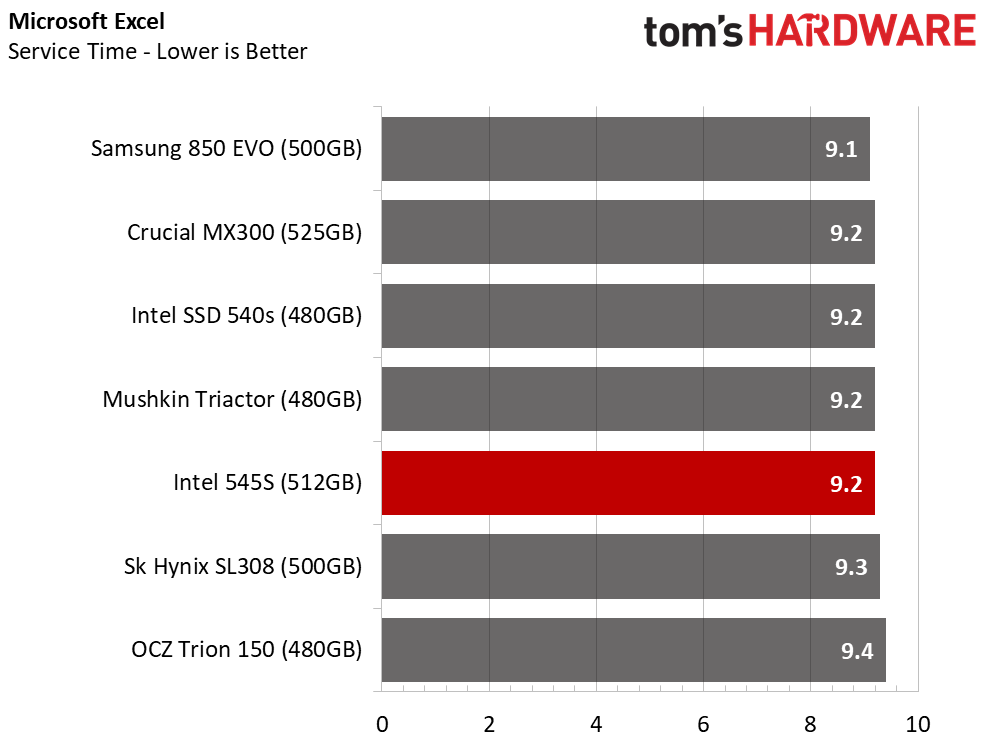
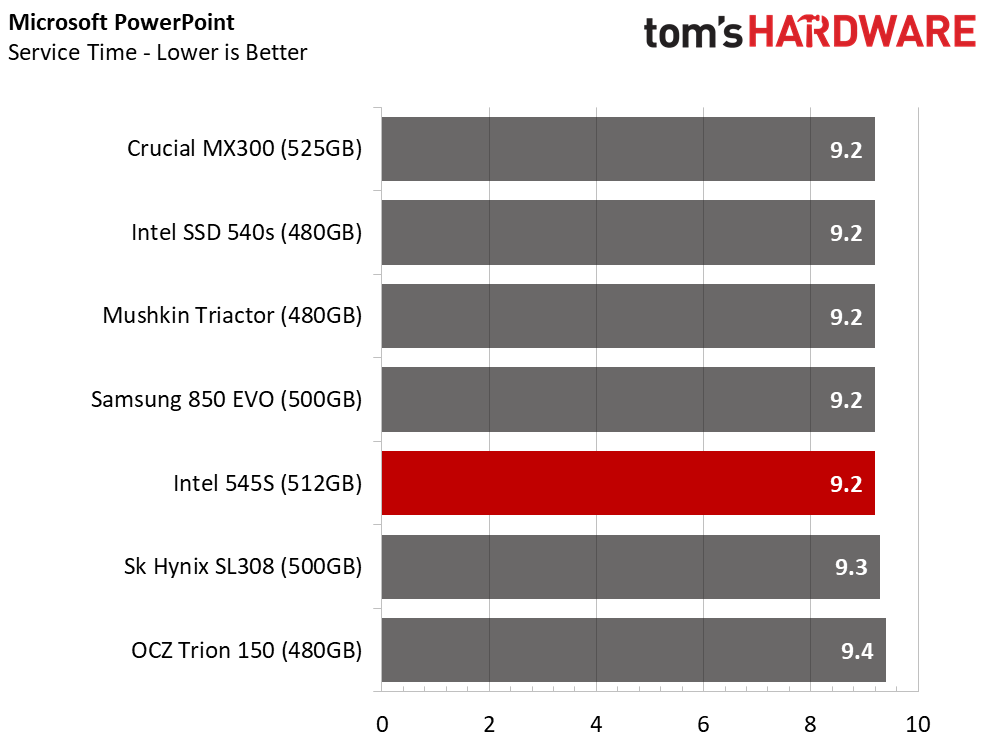
The Intel 545s 512GB performed well in the lighter read-centric workloads. It couldn't outperform the Samsung 850 EVO, but it either matched it or came very close in many of the tests. The two write-intensive Photoshop tests push the 545s further down the chart. The heaviest workloads show the previous-generation 540s with planar NAND outperforming the new 545s with 3D NAND by more than 6 seconds.
Application Storage Bandwidth
The Intel 545s provides a significant performance improvement over the 540s that uses 16nm Sk Hynix planar NAND. The 545s doesn't quite outperform the MX300 525GB with first-generation 3D NAND and a Marvell 4-channel controller. That's disheartening, but if we remove the two Photoshop tests the 545s would climb up the chart and settle just under the 850 EVO 500GB.
PCMark 8 Advanced Workload Performance
To learn how we test advanced workload performance, please click here.
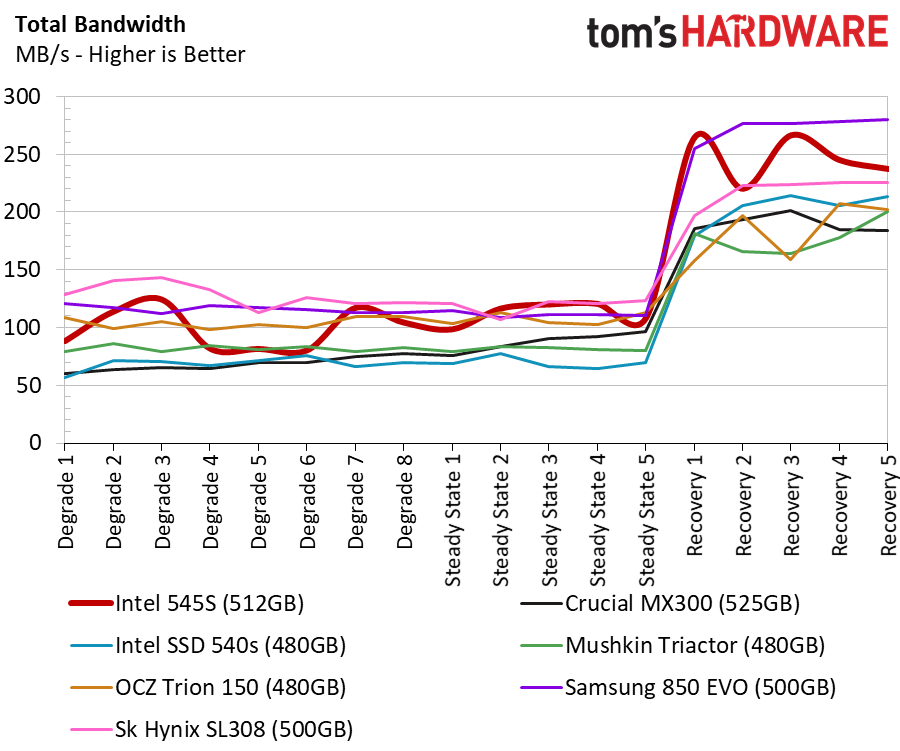
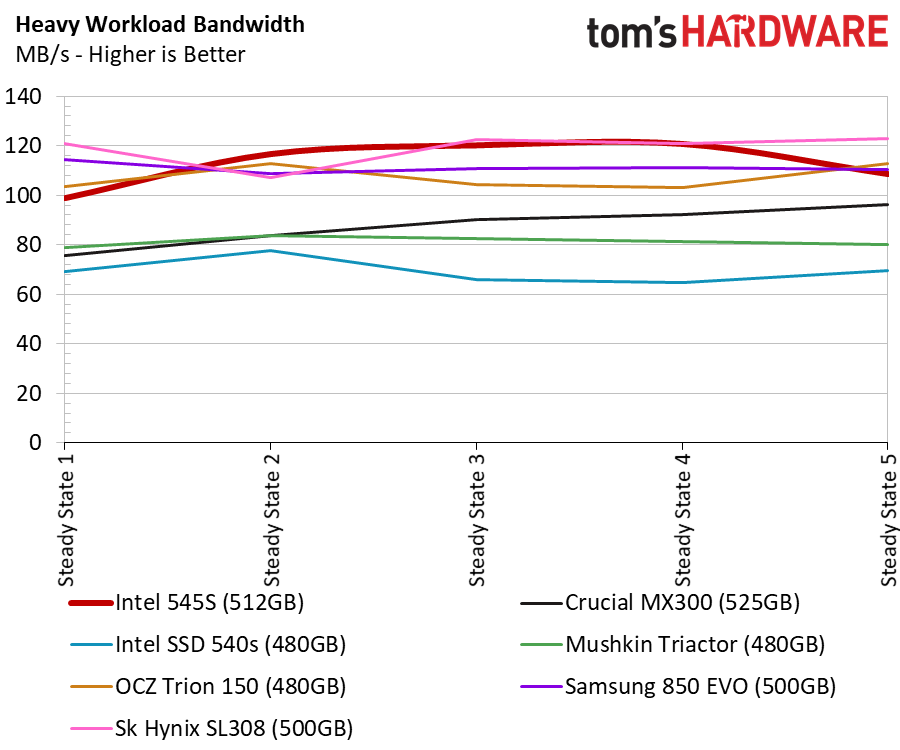

The PCMark 8 Extended Storage Test reveals inconsistent performance. We focus on the recovery phase that mimics mainstream user workloads by injecting ample idle time between each pass. Surprisingly, the 545s is also inconsistent in that section.
Total Service Time
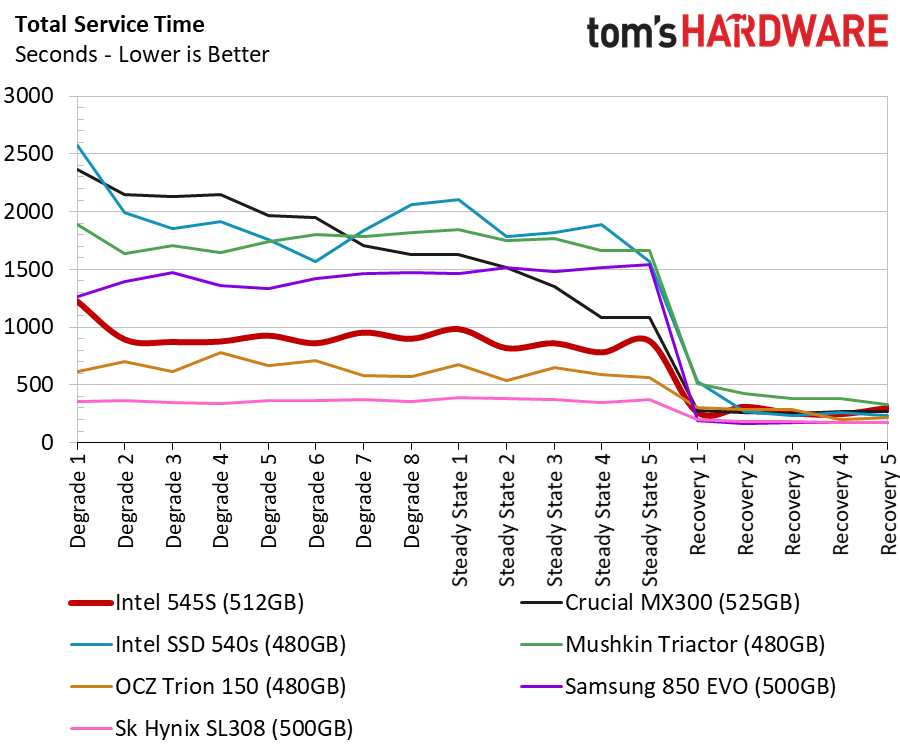
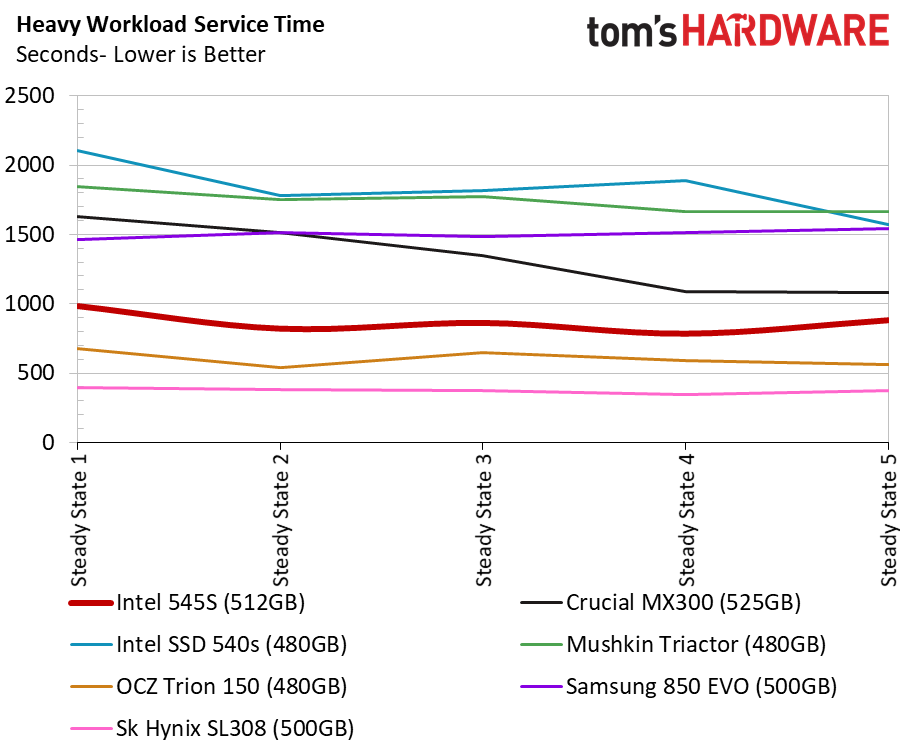
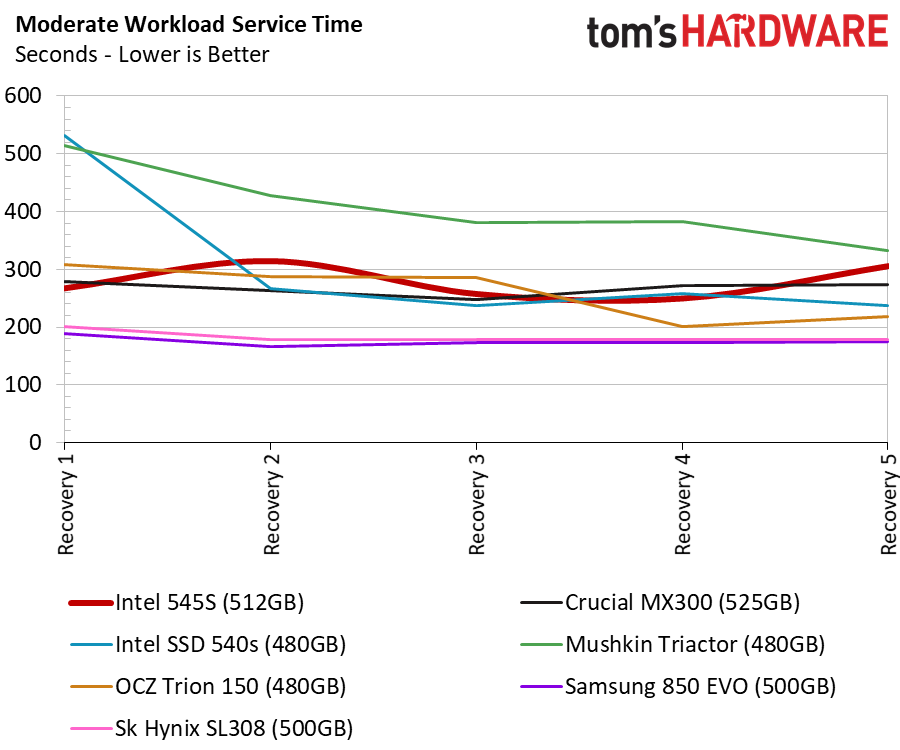
Intel managed to take a large chunk of latency out of the 545s compared to the older 540s (and even the Crucial MX300 525GB). I hate to say it because we've said it for years, but the 850 EVO still dominates consumer SATA SSDs in both heavy and moderate workloads.
Disk Busy Time
The disk busy time test shows how long each drive had to work to complete the workload. We again see a large improvement over the previous-generation 5-Series.
Responsiveness Test
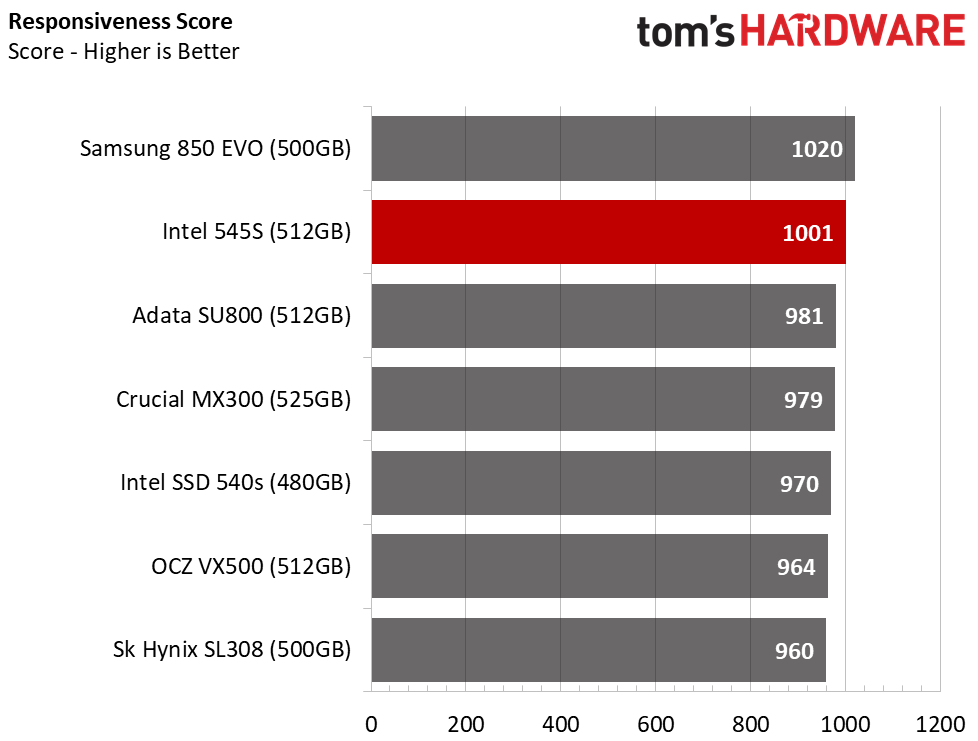
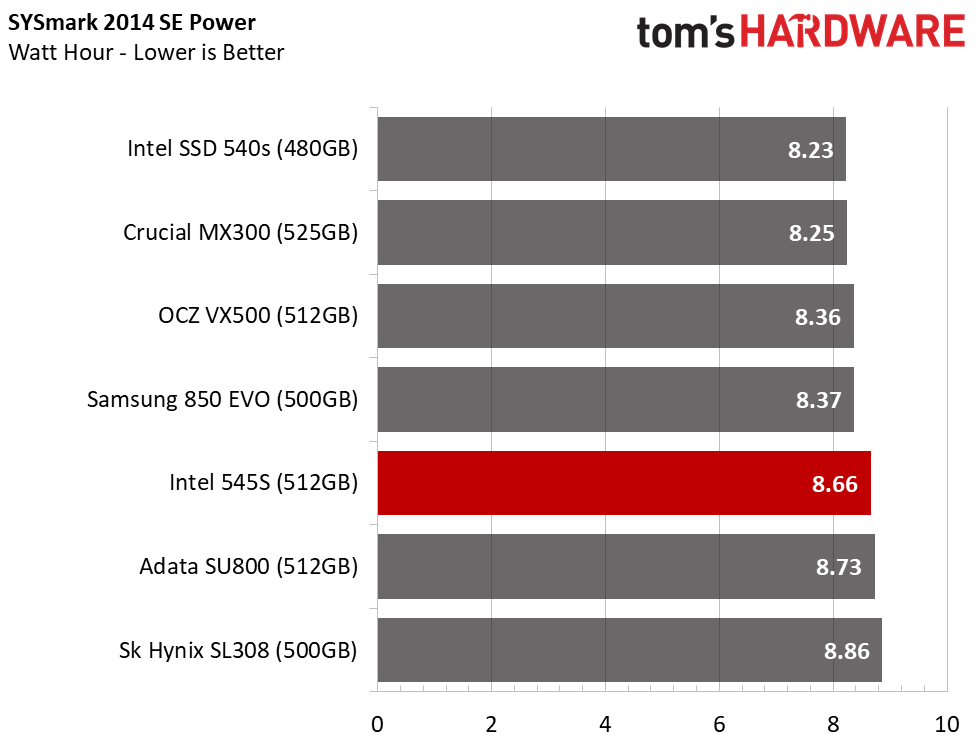
The SYSmark 2015 SE workload is lighter than the PCMark 8 Extended Storage Test because it mimics a typical office user. It provides even more idle time, which allows the SSDs to recover. The Intel 545s 512GB surpasses the 1000 baseline mark set by BAPCo with an OEM Samsung SSD (similar to the 750 EVO).
Notebook Battery Life
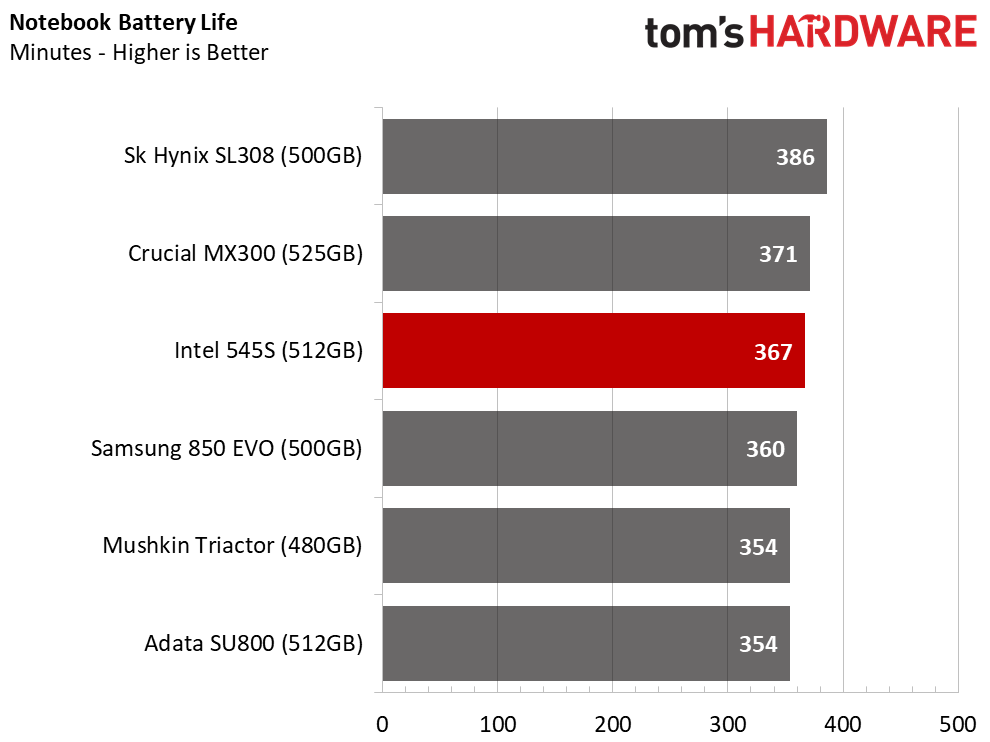
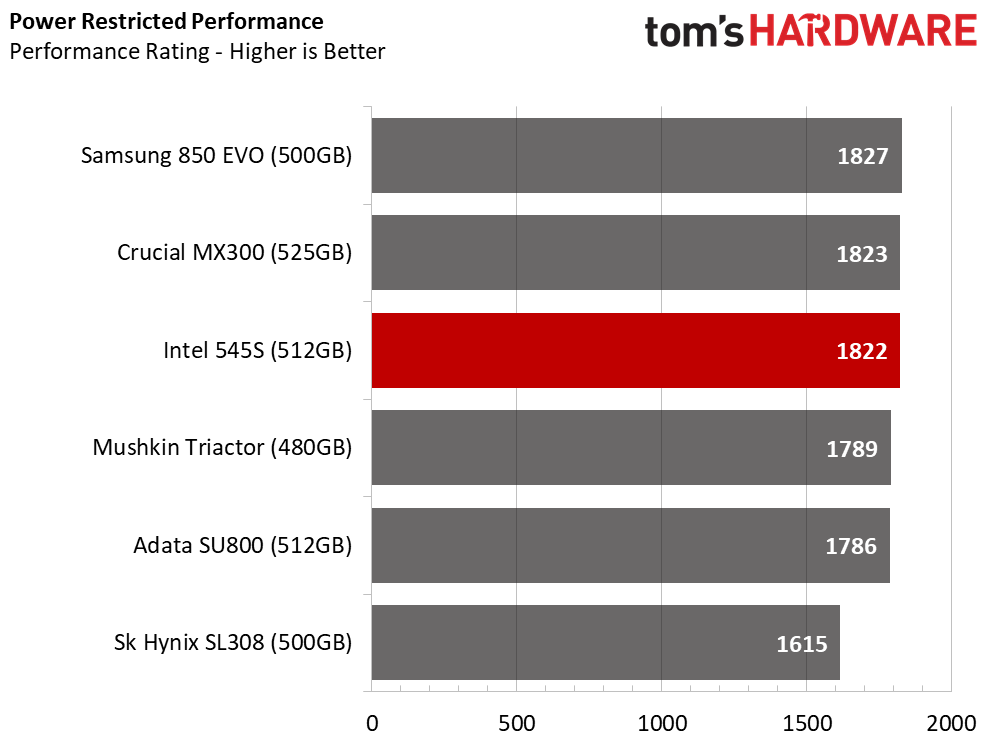
We haven't tested the Intel 540s in our Lenovo Y700-17. When the drive came to market, we used a Lenovo T460 for the BAPCo MobileMark 2014.5 test. The other drives we compare to the 545s came to market later, so we have results with the new platform. The 545s performed very well in this test and allowed the notebook to stay powered on for 367 minutes. System performance also stayed high even though the buses are running at reduced clock speeds to save power.
MORE: Best SSDs
MORE: How We Test HDDs And SSDs
MORE: All SSD Content

Chris Ramseyer was a senior contributing editor for Tom's Hardware. He tested and reviewed consumer storage.
-
hannibal Good that other makers Are gaining Samsung! Intel will newer go price war with Samsung because it does not have to. It can always sell a Little bit slover at the same price or even higher, because Intel have very good reputation among users and exspecially corporates. But this means than Sansung does not get everything too easily anymore and other ssd makers will definitely cut down under Samsung, if They just have a chance.Reply
So competition is coming back to SSD Also! Also in higher level not only on very low end. -
AgentLozen It's a shame that a big, well known company like Intel can't develop an SSD that beats a 2 year old competitor.Reply
What's important to keep in mind is that all modern SSDs are pushing against the SATA bandwidth cap. The benchmarks from this review indicate that every SSD tested performs pretty much the same in real world benchmarks.
The most important variables right now (in SATA drives) are endurance and price. 3D flash memory should provide enough endurance for any mainstream user, but I would like to see the prices go down. I know we're in the middle of a flash shortage, but I was hoping that by 2017 we would have 1TB drives that cost $200. -
derekullo The Real-World Software Performance must have been exceptionally boring to benchmark.Reply
Wow opened in ... omg 58 seconds again. -
nzalog Reply19868910 said:It's a shame that a big, well known company like Intel can't develop an SSD that beats a 2 year old competitor.
What's important to keep in mind is that all modern SSDs are pushing against the SATA bandwidth cap. The benchmarks from this review indicate that every SSD tested performs pretty much the same in real world benchmarks.
The most important variables right now (in SATA drives) are endurance and price. 3D flash memory should provide enough endurance for any mainstream user, but I would like to see the prices go down. I know we're in the middle of a flash shortage, but I was hoping that by 2017 we would have 1TB drives that cost $200.
I don't think anyone looking for top performance is going to get a Sata SSD and intel is doing just fine in their NVME PCIE drives. I'd still buy an intel drive over Samsung even if it performed a bit slower. -
DerekA_C Ya you do that support the Intel agenda that breaks laws all over the world just like Microsucks and gets a slap on the wrist and business for them continues as usual while others struggle to make even a proper market share due to their devilish practices.Reply -
DerekA_C also if manufacturers pushed for this on motherboards sata would be more then fast enoughReply
SATA revision 3.2 16 Gbit/s 1.97 GB/s
SATA revision 3.0 6 Gbit/s 600 MB/s -
nzalog Reply19870213 said:Ya you do that support the Intel agenda that breaks laws all over the world just like Microsucks and gets a slap on the wrist and business for them continues as usual while others struggle to make even a proper market share due to their devilish practices.
I'm not sure if that was directed towards me but I'm pretty sure Samsung doesn't scores much better on the ethics scale. -
jtd871 "2TB of flash ready to hold a Steam Library" This seems a bit overkill because 1) an Optane cache can reputedly make cheap and reliable "spinning rust" sing and 2) who keeps 2TB of games on local storage just in case they might want to play any random one of them?! (Or is that just Skyrim with all the mods? j/k)Reply
